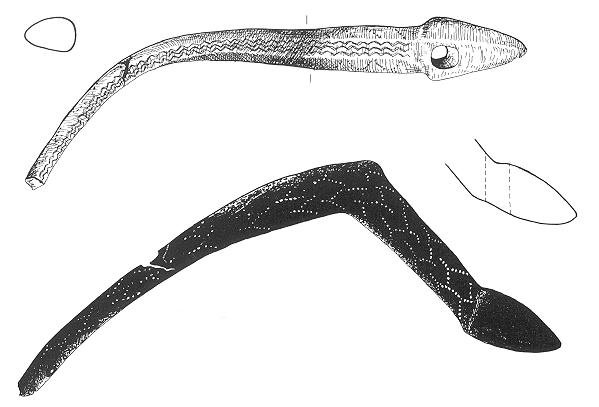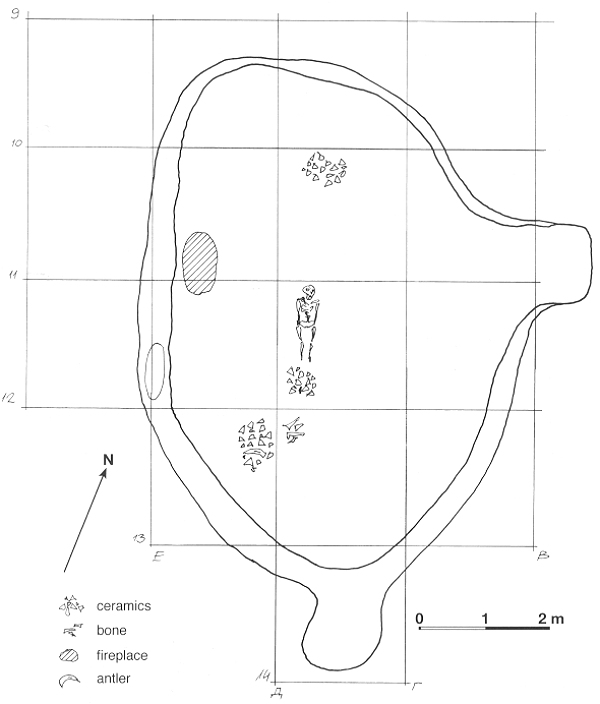STONE AGE SETTLEMENTS IN THE LOWER REACHES OF
THE NARVA RIVER, NORTH-EASTERN ESTONIA
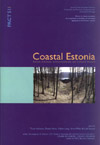
Aivar Kriiska Published: Coastal Estonia. Recent Advances in Environmental
and Cultural History. PACT 51. Rixensart 1996, 359–369.
Abstract
HISTORY OF THE EXCAVATIONS The area of the lower course of the
Narva River in north-eastern Estonia is one of the regions central to the
reconstruction of the Estonian Stone Age. It has, so far, provided the
only remaining settlement site in Estonia with three clearly distinct Mesolithic
strata. It has also yielded the only Stone Age fishing net remains and
the remains of two Neolithic dwelling houses together with burial sites.
Finally it has given its name to an entire Early Neolithic culture: the
Narva culture. The region has been studied to various degrees by all researchers
of the Estonian Stone Age.
Although a couple of stone axes were
already obtained from the lower course of the Narva River in the second
half of last century (Simenson, 1922, p. 1; Tallgren, 1922, p. 54) substantial
research only began in the 1930's. The occasion was the digging of the
main drainage canal in the Siivertsi section of the town of Narva (Fig.
1, no. 2) during the summer of 1930 and the resultant discovery of a bone
arrowhead and two long bone points at a depth of 3.4 m (Indreko, 1931,
p. 1). The artefacts were presented to the Archaeology Museum of Tartu
University by Arnold Soom, Director of the Narva Museum. That October,
Richard Indreko made minor test excavations at the site. Sandstone net
anchors with the remains of cords and pinebark floats, some bone arrowheads
and long pointed bits of bone were recovered at the excavations. These finds were probably part of a net and
objects from a boat which sank to the bottom of a lagoon during an accident in the transition period from
the Baltic Ancylus Lake to the Litorina Sea (Indreko, 1937a, p. 30; 1937b,
p. 5; 1948, p. 94). Paul William Thomson also studied the geological background
of the site, made pollen analyses and, together with Teodor Lippmaa, determined
the cord material (Indreko, 1932, p. 52 and 56; 1948, p. 94).
New finds were accidentally discovered
in 1938 along the Narva River in the course of mining for diatomite. Two
bone arrowheds and, a year later, a two arrowheads, a polishing stone
and some kind of wooden object were sent, under the direction of K. E.
Piias, to the Archaeology Museum of Tartu University from Tõrvala
(Fig. 1, no. 6), about 8 km north of Narva on the right bank of the river
(Indreko, 1948, p. 91). 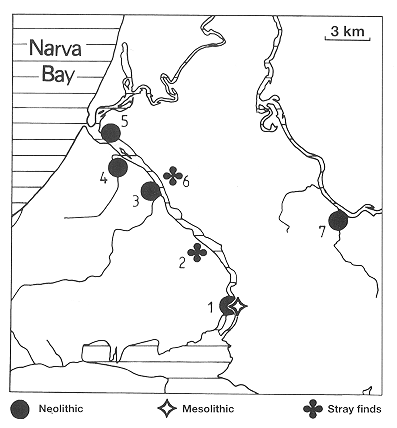
Fig. 1. Stone Age sites in the lower reaches of the Narva River. 1 – Narva Joaoru, 2 – Siivertsi, 3 – Riigiküla I–III, 4 – Kudruküla, 5 – Väiküla, 6 – Tõrvala, 7 – Lommi I–III. In addition, a small snakeshaped horn figure (Fig. 2) was obtained from the same site in 1949 (Moora, 1957, p. 225; L. Jaanits, 1961, p. 22) together with two bone daggers in 1955 (L. Jaanits, 1959, p. 1). These figures were found about 160–300 m east of the Narva River at a depth of 1.4–1.7 m in the lower diatomite layer (L. Jaanits, 1959, p. 2). Numerous finds of fishing net stones were recovered during the diatomite mining, some of the finds are from the bottom of the Litorina Sea (Indreko, 1948, p. 95) — having probably sunk during fishing. The snake-shaped figure has been considered, above all, to be a water sacrifice (L. Jaanits et al., 1982, p. 47). In 1937 Thomson made a pollen analytical study of the Tõrvala sediments (Thomson, 1937, p. 214–215), as did the Moscow palynologist G. Lissitsyna in 1959 (Lissitsyna, 1961, p. 543). In writing about the Tõrvala finds L.V. Koltsov has used the pollen analytical results of A. Laasi (Koltsov, 1977, p. 129). Lembit Jaanits inspected the Tõrvala site archaeologically in 1958. The first Stone Age settlement site was discovered in 1939. A border guard found pottery sherds in road gravel transported from the bank of the stream Notika, which flows into the Luga River, near Lommi village (Fig. 1, no. 7) about 8 km east of Narva. The finds ended up in the Narva Museum, and from there were sent to the Archaeological Museum along with further finds and a report by the museum director A. Soom, who inspected the site that same autumn (Soom, 1939). During the summer of 1940, archaeological excavations were carried out by R. Indreko. In the Notika delta he discovered traces of three Neolithic settlements (Lommi I–III) (Indreko, 1940). The object of his excavations was the larger site on the right bank of the Notika stream (settlement III). In 1952 Leningrad archaeologist Nina Gurina excavated the same site (Gurina, 1961, p. 410–412). The material collected on that occasion belongs primarily to the Typical and less to the Late Combed Ware Pottery period. The foundation of the settlement is, however, marked by a few Narva-type pottery sherds (Kriiska, 1994, p. 11). Small tools of good-quality flint were also found (Indreko, 1964, p. 63) and some quartz-scrapers, burins and arrowheads, finely-polished slate wedges, numerous polishing stones and fragments of clay sculptures (Fig. 3), along with amber beads and pieces of amber.
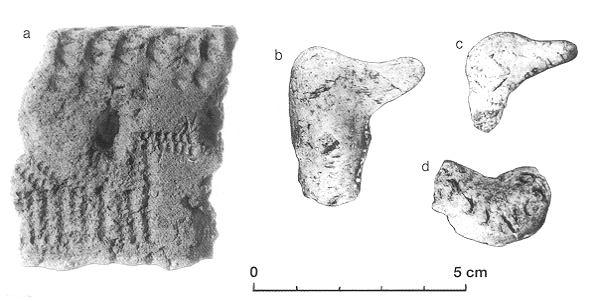
c – AI 3867 : 247, d – AI 3867 : 310) found in the Lommi III settlement. The 1950's mark the beginning of more intensive archaeological research. In connection with the construction related to the Narva hydroelectric plant, N. Gurina began searching for Stone Age relicts around Narva. About 8 km north of the town at Riigiküla (Fig. 1, no. 3), opposite to the Tõrvala site, on the left bank of the Narva River, she detected at first one and later two more Neolithic settlements (Riigiküla I–III). As early as 1929, a local farmer had found a stone wedge at Riigiküla and in 1938, a ring. The artefacts were once again forwarded by A. Soom to the Archaeological Museum. Oskar Saadre inspected the site in 1938, but test excavations were not possible, because the site was situated under a cultivated field. N. Gurina discovered one settlement in 1951 (Riigiküla I), during its excavation yet another (Riigiküla II) and, in 1952, during continued excavations, the third (Riigiküla III) settlement (Gurina, 1955, p. 53). She excavated at all three settlements between 1951 and 1953. L. Jaanits inspected Riigiküla III in 1957 and in 1958 performed minor excavations. Samples for pollen analysis were taken at settlement III in 1959 by Lissitsyna (Lissitsyna, 1961, 540). Riigiküla was also inspected in 1962, 1970 and 1991. During the last inspection, the cultural layer of a settlement IV was determined and phosphate analysis made (K. Jaanits et al., 1991). The excavations are summarized in Table I. TABLE I. ARCHAEOLOGICAL EXCAVATIONS OF THE STONE AGE SITES/MONUMENTS AT THE LOWER COARSE OF THE NARVA RIVER.
DESCRIPTION OF THE SETTLEMENT SITES The Riigiküla settlements are
situated in the north-western part of a sandy ridge — a spit of the Litorina Sea — on the
present-day banks of the Narva and
Tõrvajõe rivers. Narva-type Pottery, Typical Combed Ware
Pottery and Late Combed Ware Pottery have been found at each of the settlements
excavated. Typical Combed Ware Pottery prevails at Riigiküla I–II
and Narva Pottery at Riigiküla III (Gurina, 1967, p. 49).
The cultural layer of settlement
I was 40–70 cm thick, reaching a thickness of 1.2 m in the area
of the dwellings. Two dwelling remains were excavated. Both were situated
on a line parallel to the river. The outline of the northernmost was circular,
with a diameter of about 8 m and sunken 30 cm into the sandy surface. In
the center of the building remains was a circular stoneless hearth, situated
35–40 cm above the sandy ground. At the same height, on the eastern
side of the building, an adult male skeleton was found buried, laying stretched
out on its back. Since the cultural layer of the settlement was covered
by soil, it was not possible to distinguish grave goods (Gurina, 1967,
p. 22–23). Anthropologically, the skeleton is of Protolapponian-type
(Mark, 1975, p. 46). The southernmost dwelling remains had an oval ground
plan with a diameter of 6–8 m (Fig. 4). Its base was also sunken
about 30 cm into the sandy surface. The southern side of the dwelling had
a protruding square area (Gurina, 1955, p. 160). Near the western wall
was a stoneless hearth about 1 m in diameter, and in the center a child's
skeleton was discovered, again stretched out on its back. Grave goods may
have included fragments of a large vessel from the Late Combed Ware Pottery
period at the feet and a small scraper (Gurina, 1967, p. 29). The skeleton
belongs to the Europoid anthropological type (Mark, 1975, p. 46).
Two hearths
were also found outside the dwellings. A large number of finds were collected:
flint arrowheads, scrapers, burins, knives, polishing stones and fragments,
axes and wedges of slate and horn, arrowheads and fishing spears of bone,
tooth pendants and beads made from the long bones of birds (Gurina, 1967,
p. 123, 138 and 141).
The cultural layer of settlement
II was, on average, 50–60 cm thick. Hearthstones were found depressed
into the ground along with some waste pits (Gurina, 1967, p. 16). Flint
scrapers, arrowheads and nuclei were discovered, along with a small quartz
tool and slate pendants. Bone finds were few — one wedge and a
pointed sherd of long bone (Gurina, 1967, p. 60).
The cultural layer of settlement
III was mostly 70 cm thick, but up to 1 m in places. One sunken hearthstone
and some waste pits were excavated. Relatively few stone artefacts were
found. Arrowheads and scrapers of low-quality local flint were discovered,
plus quartz saw bits, horn wedges and axes and bone arrowheads and fishing
spears along with some tooth pendants (Gurina, 1967, p. 46). The rarest
find is a small sculpture of moose horn resembling a moose head and neck
(L. Jaanits, 1961, p. 9).
Stone Age finds were discovered in
Joaoru (Fig. 1, no. 1), in the town of Narva, in 1953. News of the finds
reached the Institute of History, the Estonian Academy of Sciences, in
Tallinn through the director of the Narva Museum and a local history teacher
(Faronov, 1953; Zubov, 1953). L. Jaanits made six minor test excavations
in Joaoru in 1954. Neolithic finds were stumbled upon below later cultural
strata, and Mesolithic finds in the test excavation situated further from
the river (L. Jaanits, 1955, p. 179 and 180). Excavations continued in
Joaoru in 1957, 1960 and 1962–64 (L. Jaanits, 1965, p. 36–37).
At Joaoru, one Neolithic and three
Mesolithic layers were distinguished stratigraphically below the later
layers (L. Jaanits et al., 1982, p. 44). The oldest layer (III)
was situated directly on the bedrock. The cultural layer contained much
charcoal, which gave 14C-datings of 7640±180
BP (TA-53), 7580±300 BP (TA-25) and 7090±230 BP (TA-41)
(Ilves et al., 1974, p. 175). The settlement layer has later been
covered by a sandy stratum, which increases in thickness towards the river.
Upon the latter rests a further cultural layer (II). It is thicker than
the previous and richer in finds, and comprised numerous hearths, including
an almost square-shaped stone hearth. The II Mesolithic settlement was
dated by 14C to 7375±190 BP (TA-52),
6740±250 BP (TA-40) and 6020±120 BP (TA-17) (Ilves et
al., 1974, p. 175). This layer is also covered by sand, which is
thicker and more extensive than the sandy layers between the cultural layers
II and III. The upper Mesolithic layer (I) was slightly thinner than the
others and poorer in artefacts. About ten hearths were found, most of them
of stone.
In the highest section of the settlement,
evidently associated with layer I, the poorly preserved grave of a child
was excavated (L. Jaanits et al., 1982, p. 45). This layer was radiogarbon
dated to 5820±200 BP (TA-33) and 5300±250 BP (TA-7).
Altogether about 1200 different types of objects, most of which are small
quartz tools (scrapers, burins and so forth) were found from Mesolithic
stratum. Flint was used very little. Bone objects are plentiful, however,
mostly as fragments: fishing spears and arrowheads, wedges, awls and daggers
etc. (L. Jaanits et al., 1982, p. 47 and 48).
The lower part of the Neolithic stratum
contained predominantly Narva-type Pottery. The overlaying part was mostly
mixed and included Narva-type Pottery, Typical and Late Combed Ware Pottery
and also Early and Late Corded Ware (L. Jaanits, 1965, p. 37; Kriiska,
1994, p. 52–70). Besides pottery, flint and bone arrowheads, fragments
of polishing stones, quartz and flint scrapers, slate wedges and an amber
pendant were also recovered.
At the end of the 1960's and beginning
of the 1970's, a Neolithic settlement was discovered 5 km upstream from
the mouth of the Narva River, about 500 m to the southwest, on the left
bank of the Kudruküla stream (Fig. 1, no. 4). The cultural layer of
the settlement was most probably swept away by a stream and deposited on
the bottom of a flat valley-like depression. Eldar Efendijev, director
of the Narva Museum, collected finds from Kudruküla during the 1970's
and especially in 1979. That same year, L. Jaanits partly inspected the
site. Kaarel Jaanits carried out archaeological excavations in Kudruküla
in 1980 (K. Jaanits, 1981, p. 385) and E. Efendijev in 1981 (Efendijev,
1983, p. 396).
A very substantial collection has
been gathered from this settlement site, comprising abundant bone and horn
objects, arrowheads and fishing spears, needles, awls and tooth pendants.
Stone articles are few, single flint fragments, arrowheads, scrapers, polishing
stones and slate wedges. An amber pendant was also found. Animal bones
and single human bones, including some skull fragments, were also obtained
from the stratum. The majority of the pottery belongs to the Late Combed
Ware Pottery period and a small part to the Typical Combed Ware Pottery
period (Kriiska, 1994, p. 10).
In the beginning of the 1980's, members
of the Narva scuba diver's club discovered Neolithic finds near Väiküla,
in a water depth of about 4 m in the Narva River, 1.5–2 km upstream
from the mouth of the river, and 15–20 m from the right bank.
In 1983, the discovery site was localized and finds were collected by the
direction of E. Efendijev and Valeri Petrenko (Petrenko and Efendijev,
1985, p. 453). So far only 69 Neolithic pottery sherds have been found,
one of them is Typical Combed Ware Pottery and the rest are Late Combed
Ware Pottery. ACKNOWLEDGEMENTS The manuscript was translated from Estonian to Englisch by Karl S. Altan, Helsinki and revised by Hille and Valdar Jaanusson, Stockholm. Aivar Kriiska
REFERENCES EFENDIJEV, E.F., 1983,
Raskopki v zapadnom Prinarovje. — Archeologitsheskie otrõtija
1981. goda, Moskva, 396 p.
FARONOV, I., 1953, Pismo direktoru Instituta Istorii Akademija Nauk ESSR t. Maamjagi. 8.
08 (Manuscript in the Institute of History, Estonian Academy of Sciences).
GURINA, N.N., 1955, Novõe neolititsheskie pamjatniki v vostotshnoi Estonii, in
Muistsed asulad ja linnused, Tallinn, p. 153–175.
GURINA, N.N., 1961, Drevnjaja istorija Severo-Zapada Jevropeiskoi tshasti SSSR, in
Materialõ i issledovanija po arheologii SSSR, 87, Moskva–Leningrad.
GURINA, N.N., 1967, Iz istorii drevnih plemen zapadnõh oblastei SSSR,
in Materialõ i issledovanija po arheologii SSSR, 144,
Moskva–Leningrad.
ILVES, E., LIIVA, A., PUNNING, J., 1974, Radiouglerodnõi metod i ego primenenie v
tshetvertitshnoi geologii i arheologii Estonii, Tallinn.
INDREKO, R., 1931, Kaevamistest Siivertsis Narva linna piiril Tuuliku t. 30, Siirak Munaku
krundil (Manuscript in the Institute of History, Estonian Academy of
Sciences).
INDREKO, R., 1932, Kiviaja võrgujäänuste leid Narvas, in Eesti
Rahva Muuseumi Aastaraamat, VII, Tartu, p. 48–67.
INDREKO, R., 1937a, Eesti ürgaeg, in Elav Teadus, 69,
Tartu.
INDREKO, R., 1937b, Muinasaegsest kalandusest Eestis, in Kalanduskoja
Toimetised, 2, Tallinn.
INDREKO, R., 1940, Kaevamised 2. VII 40. Ekaterina Hämelaineni (Jaan Saare) tl. maal
Narvataguse, Narva vld. Lommi kruusaaugus, Notika oja ääres,
mis jookseb Luuga jõkke (Manuscript in the Institute of History,
Estonian Academy of Sciences).
INDREKO, R., 1948, Die mittlere Steinzeit in Estland. Mit einer übersicht über
die Geologie des Kunda-Sees von K. Orviku, in Kungliga Vitterhets
Historie och Antikvitets Akademiens handlingar, 66, Stockholm.
INDREKO, R., 1964, Mesolithische und frühneolithische Kulturen in Osteuropa und
Westsiberien, in Kungliga Vitterhets Historie och Antikvitets Akademiens handlingar.
Antikvariska Serien, 13, Stockholm.
JAANITS, K., 1981, Raskopki v Muuksi i Kudrukjula, in Arheologitsheskie
otkrõtija 1980 goda, Moskva, p. 384–385.
JAANITS, K., KRIISKA, A., SHEVELJOV, V., 1991, Aruanne arheoloogilisest inspektsioonist
Narva jõe alamjooksul nov.–dets. 1991. a (Manuscript in the
Institute of History, Estonian Academy of Sciences).
JAANITS, L., 1955, Neoliitilised asulad Eesti NSV territooriumil, in Muistsed
asulad ja linnused, Tallinn, p. 176–201.
JAANITS, L., 1959, Ottshet o razvedke na meste nahozhdenija mezolititsheskih predmetov
na pravom beregu reki Narvõ, v karjere diatomita v Tõrvala
Leningradskoi oblast (Manuscript in the Institute of History, Estonian
Academy of Sciences).
JAANITS, L., 1961, Jooni kiviaja uskumustest, in Religiooni ja ateismi
ajaloost, II, Tallinn, 5–70.
JAANITS, L., 1965, Über die Ergebnisse der Steinzeitforschung in Sowjetestland,
in Finskt Museum, LXXII, p. 5–46.
JAANITS, L., LAUL, S., LÕUGAS, V., TÕNISSON, E., 1982, Eesti
esiajalugu, Tallinn.
KOLTSOV, L.V., 1977, Finalnõi paleolit i mezolit Juzhnoi i Vostotshnoi
Pribaltiki, Moskva.
KRIISKA, A., 1994, Narva jõe alamjooksu ala neoliitiline keraamika.
Magistritöö (Manuscript in the Institute of History, Estonian Academy of
Sciences).
LISSITSÕNA,
G.N., 1961, Voprosõ paleogeografii neolita raionov ceverozapada
Evropeiskoi tshasti SSSR, in Prilozhenie No. 3 k knige N. N. Gurinoi
"Drevnjana istorija Severo-Zapada Jevropeiskoi tshasti SSSR. Material i
issledovanija po arheologii SSSR, 87. Moskva–Leningrad.
MARK, K., 1975, Antropologija
pribaltiisko-finskih narodov, Tallinn.
MOORA, H., 1957, Eine steinzeitliche Schlangenfigur aus der Gegend von Narva, in
Suomen Muinaismuistoyhtistyksen Aikakauskirja, 58, p. 225–232, Helsinki.
PETRENKO, V.P., EFENDIJEV, E.F., 1985, Rabotõ na territorii Estonii i Leningradskoi
oblasti, in Arheologitsheskie otkrõtija 1983 goda, Moskva, p. 453.
SAADRE, O., 1938, Aruanne Vaivara kihelk. Riigiküla kiviriistade leiukoha
inspekteerimisest 1. juulil 1938 (Manuscript in the Institute of History, Estonian Academy
of Sciences).
SIMENSON, E., 1922, Vaivara kihelkond (Manuscript in the Institute of History,
Estonian Academy of Sciences).
SOOM, A., 1939, Kiri Tartu Ülikooli Arheoloogia Kabinetile. 5 oktoober
(Manuscript in the Institute of History, Estonian Academy of Sciences).
TALLGREN, A.M., 1922,
Zur Archäologie Eestis, I. Vom Anfang der Besiedlung bis etwa 500
n. Chr in Acta Commentationes Universitatis Tartuensis (Dorpatensis)
B, 6, Dorpat.
THOMSON, P.W., 1937, Narva diatomiit, Eesti Loodus, 5, Tartu, p.
214–216.
ZUBOV, V., 1953, Pismo
tov. Maamjagi B. A. 2.08. (Manuscript in the Institute of History,
Estonian Academy of Sciences). |
